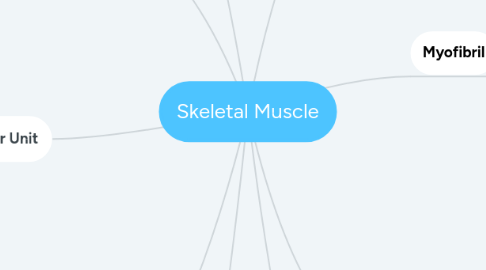
1. Motor Unit
1.1. Muscle fibres + Somatic motor neurone
1.2. All -or- Nothing contraction
1.3. Graded Response - Change No./Type activated units
1.3.1. Fine motor e.g Eye - 3 to 5 fibres
1.3.2. Gross Motor e.g large muscle - 2000 fibres
2. Glycogen + pH
2.1. Anarobic metabolism = Lactate and H+ --> Dec. pH
2.2. Dec pH = reduced bacterial growth.
2.3. Stress - mixing/ long transport distances = High pH = Inc. chance of meet going bad.
3. Classification of Muscle fibres
3.1. Type 1 - Slow twitch - Oxidative - Red muscle
3.1.1. Slow sustained movements
3.1.2. Increased myoglobin, mitochondria and blood vessels
3.1.3. Energy = oxidative phosphorylation - aerobic
3.2. Type 11A - Fast twitch : Oxidative-Glycolytic - Red muscle
3.3. Type 11B - Fast twitch: Glycolytic - White muscle
3.3.1. Fast & high power output
3.3.2. Increase No. Myofilaments
3.3.3. Anaerobic Glycolysis - Fatigue easily
4. Contol of contraction
4.1. 1. Neuromuscular Junction
4.1.1. Somatic motor neurone --> Acetylcholine - Bind --> nicotinic cholinergenic receptor.
4.1.1.1. Influx of Na+ = End plate potential
4.2. 2. Excitation-Contraction coupling
4.2.1. AP --> sarcolemma - t tubules = Ca2+ realease - SR
4.2.1.1. Ca2+ -->troponin = free actin binding site - Cross bridges
4.2.2. Timing - 1 Relax/Contract Cycle = Twitch
4.2.2.1. Twitch --> 2nd AP = latent period ( - biochemical processes)
5. Factors affecting contraction force.
5.1. Length - Tension
5.1.1. Optimum overlap - Z lines not too close/ far apart before contraction.
5.2. Summation
5.2.1. Close stimuli - Relax failure = summation - Tetanus (Prolonged Contraction)
6. Muscle Fibre
6.1. Sarcolemma
6.1.1. T- tubules - Rapid AP transmission
6.2. Sarcoplasmic Reticulum
6.2.1. Termina Cisternae - SR Ca ATPase - Ca2+ into SR
6.3. Sarcoplasm
7. Myofibril
7.1. Repeating sarcomere units
7.1.1. Z- Lines - myosin + actin
7.2. Shorten in contraction
7.2.1. Isotonic - contract + shortens --> move load
7.2.2. Contaction - Myosin heads form cross bridges with actin. --> ATP
7.2.2.1. Tension ∝ No. Cross bridges
7.2.3. Isometric - Contact + NO shortening --> load NOT moved
8. Meat Tenderness
8.1. Aerobic metabolism stops but ATP is produced.
8.2. Cross bridges broken = Tender
8.2.1. Storage - Hung - Actin and Myosin bond broken by proteolytic enzymes.
8.3. 8 - 15hrs = Glycogen deminished = rigor mortis + tough meat
9. Contraction and ATP
9.1. Na - K ATPase restores Na+ and K+.
9.2. Myosin ATPase (Contraction) and Calcium Pumps
9.3. ATP + creatine --> ADP +phosphocreatine CREATINE KINASE
9.4. Glycolysis - Very fast, Anaerobic or Aerobic
9.4.1. Glucose + 2 NAD(+) + 2ADP + 2P --> Pyruvate + 2NADH + 2H(+) + 2ATP + 2h20
9.4.2. NAD+ replenished in oxidative phosphorylation.
9.4.3. Anaerobic
9.4.3.1. Pyruvate + NADH + H+ --> Lactate + NAD+
9.4.3.2. Lactic acidosis - due to acidic metabollic waste.
